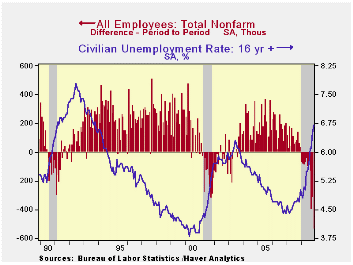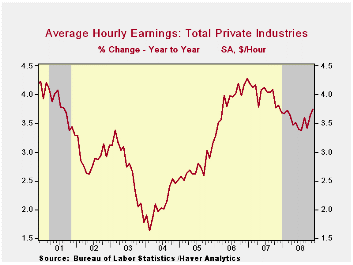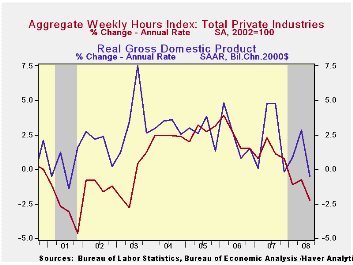 Global| Dec 05 2008
Global| Dec 05 2008U.S. Payrolls Slashed 533,000; 6.7% Jobless Rate Highest Since 1993
by:Tom Moeller
|in:Economy in Brief
Summary
Nonfarm payrolls were slashed during November by the most during any one month since December 1974. The 533,000 decline followed shortfalls of 320,000 and 403,000 during October and September, both of which were larger than reported [...]

Nonfarm payrolls were slashed during November by the most during any one month since December 1974. The 533,000 decline followed shortfalls of 320,000 and 403,000 during October and September, both of which were larger than reported earlier by the Bureau of Labor Statistics. Also, the latest exceeded Consensus expectations for a 323,000 drop. So far in 2008, nonfarm payrolls are down 1.9 mil., or 1.4%.
During the last three months, payrolls fell at a 3.6% annual rate. That is the quickest rate of decline since during the recession of 1980.
 Aggregate hours worked, which is employment times the length
of the average workweek, so far in 4Q are down at a 4.0% annual rate.
During the last thirty years there has been a 73% correlation between
the growth in aggregate hours worked and real GDP growth.
Aggregate hours worked, which is employment times the length
of the average workweek, so far in 4Q are down at a 4.0% annual rate.
During the last thirty years there has been a 73% correlation between
the growth in aggregate hours worked and real GDP growth.
The unemployment rate rose further to 6.7% last month, the highest level since October 1993. The increase fell short of Consensus expectations for a rise to 6.8%. The jump owed to a 673,000 drop in employment (-1.6% y/y), as measured in the household survey. The latest monthly drop in household sector employment was the ninth this year and was the largest since the recession of 2001.
The number of those who were unemployed last month rose 251,000 (43.9% y/y). The figure is up 2.676 million, or 35.0%, so far this year. The November labor force fell 422,000 (+0.5% y/y) and the y/y rate of increase dropped to near its slowest since 2004. The labor force participation rate fell to 65.9% as the number of "discouraged" workers, i.e. the number of people of who want a job but are not in the labor force, jumped 398,000. The y/y increase of 15.2% is near the strongest in over ten years.
The average duration of unemployment slipped to 18.8 weeks after having increased during October by more than one full week. The median duration of unemployment also slipped m/m to 10.0 weeks, up from 8.5 weeks during all of last year. The number of those unemployed for more than 27 weeks also slipped m/m. Nevertheless it remained up by more than one-half versus last November and at the highest since 1992.
From the establishment survey the number of private sector jobs fell 540,000 (-1.8% y/y) after a 362,000 decline during October, initially reported as down by 263,000. Private service sector industries shed 377,000 jobs (-3.1% y/y) and that was the tenth decline in the last eleven months. Employment in professional & business services fell 136,000 (-2.7% y/y) led by a 111,800 decline in the administrative & waste category which was off 6.2% y/y. Temporary help services jobs, which often are a leading indicator of employment growth, fell 78,200 (-15.4% y/y). That was the largest y/y decline since 2001. Jobs in the leisure & hospitality sector fell 76,000 (-1.0% y/y) while employment in financial industries fell 32,000 (-1.8% y/y), a rate of decline that has more than doubled during the last three months. Retail sector jobs fell another 91,300 (-3.0% y/y) and the rate of decline also has doubled recently. Finally, motor vehicle dealership jobs fell 27,100 (-6.6% y/y), off at a 14.0% rate during the last three months. To the upside were jobs in the education & health industries, up 52,000 (3.0% y/y).
Construction sector employment fell by 82,000 (-7.6% y/y and at a 10.8% rate during the last three months.
Factory sector jobs fell another 85,000 (-4.5% y/y). Motor vehicle & parts jobs dropped 13,100 (-14.9% y/y) while furniture & parts jobs declined by 6,600 (-11.7% y/y. In the nondurables sector employment fell 23,000 (-3.0% y/y).
Government sector jobs moved higher again, last month by 7,000 (1.2% y/y). Local governments added 1,000 (1.0% y/y) workers and state governments added 6,000 (1.6% y/y). The number of federal government jobs was unchanged (1.6% y/y).
Comparing Current Payroll Employment Changes with Past Recessions from the Federal Reserve Bank of Cleveland is available here.
The length of the average workweek fell to 33.5 hours, down slightly from the 3Q average. That was the shortest workweek on record
Continuing to suggest continued declines in employment was the one month diffusion index, which measures the breadth of job gain or loss (50 is the break-even level). It fell to its lowest level of this cycle (27.6%). The three-month index also was at its cycle low at 27.0% and the three-month figure for the factory sector was even weaker at 20.2%.
Average hourly earnings rose 0.4%. Earnings the factory sector rose 0.3% (3.0% y/y) and private services wages rose 0.4% (3.8% y/y). Figures prior to November were revised up.


| Employment: 000s | November | October | September | Y/Y | 2007 | 2006 | 2005 |
|---|---|---|---|---|---|---|---|
| Payroll Employment | -533 | -320 | -403 | -1.4% | 1.1% | 1.8% | 1.7% |
| Previous | -- | -240 | -244 | -- | 1.3% | 1.9% | 1.7% |
| Manufacturing | -85 | -104 | -69 | -4.5% | -1.9% | -0.5% | -0.6% |
| Construction | -82 | -64 | -55 | -7.6% | -1.0% | 4.9% | 5.2% |
| Service Producing | -370 | -153 | -286 | -0.6% | 1.6% | 1.8% | 1.8% |
| Average Weekly Hours | 33.5 | 33.6 | 33.6 | 33.8 (Nov. '07) | 33.8 | 33.9 | 33.8 |
| Average Hourly Earnings | 0.4% | 0.3% | 0.2% | 3.7% | 4.0% | 3.9% | 2.7% |
| Unemployment Rate | 6.7% | 6.5% | 6.1% | 4.7% (Nov. '07) | 4.6% | 4.6% | 5.1% |
Tom Moeller
AuthorMore in Author Profile »Prior to joining Haver Analytics in 2000, Mr. Moeller worked as the Economist at Chancellor Capital Management from 1985 to 1999. There, he developed comprehensive economic forecasts and interpreted economic data for equity and fixed income portfolio managers. Also at Chancellor, Mr. Moeller worked as an equity analyst and was responsible for researching and rating companies in the economically sensitive automobile and housing industries for investment in Chancellor’s equity portfolio. Prior to joining Chancellor, Mr. Moeller was an Economist at Citibank from 1979 to 1984. He also analyzed pricing behavior in the metals industry for the Council on Wage and Price Stability in Washington, D.C. In 1999, Mr. Moeller received the award for most accurate forecast from the Forecasters' Club of New York. From 1990 to 1992 he was President of the New York Association for Business Economists. Mr. Moeller earned an M.B.A. in Finance from Fordham University, where he graduated in 1987. He holds a Bachelor of Arts in Economics from George Washington University.






